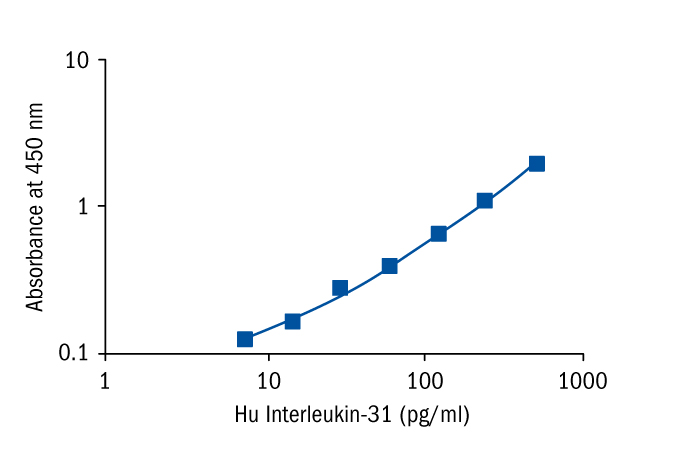Type
Sandwich ELISA, Biotin-labelled antibody
Applications
Serum, Plasma-EDTA, Plasma-Heparin, Plasma-Citrate, Cell culture supernatant
Sample Requirements
50 µl/well
Shipping
At ambient temperature. Upon receipt, store the product at the temperature recommended below.
Storage/Expiration
Store the complete kit at 2–8°C. Under these conditions, the kit is stable until the expiration date (see label on the box).
Calibration Curve
Calibration Range
7.8–500 pg/ml
Limit of Detection
1.0 pg/ml
Research topic
Cytokines and chemokines and related molecules
Summary
IL-31 is a 24kD and 164 AA α-helical protein with a four-helix bundle structure, preferentially produced by CD 4+ type 2 helper T cells (Th2). IL-31 is closely related to the IL-6 type cytokines such as oncostatin M (OSM), Leukemia inhibitory factor (LIF) and cardiotrophin 1(CT-1). IL-31 signals via binding to a heterodimeric complex that is composed of IL-31 receptor A (IL-31RA) that is highly homologous with the gp 30-like receptor and oncostatin M receptor subunits.
These receptor subunits are expressed in activated monocytes, in epithelial cells, and keratinocytes respectively.
On target cells IL-31 binding can induce activation of the JAK/STAT, AKT and MAPK signaling pathways. Due to the ubiquitous expression of its receptor complex, IL-31 has numerous physiological roles including regulation of hematopoiesis and immune response.
When overexpressed in transgenic mice, IL-31 induces severe pruritus resembling eczema in humans. Serum IL-31 was previously found overexpressed in adults with atopic dermatitis (AD).Serum measurement of IL-31 in paediatric atopic dermatitis revealed that elevated levels correlate with severity scoring. Activated effector T cells are recruited to the skin by chemokines and cell adhesion molecules. These components in the local microenvironment prolong T cell survival and contribute to the chronicity of these diseases.
IL-31 is associated with the promotion of allergic and chronic inflammatory conditions such as dermatitis, pruritus, airway hypersensititvity and inflammatory bowel disease.
Find documents for the lot
Example Instructions for Use (RUO)
Example Instructions for Use (RUO)
Safety Information (RUO)
MSDS (RUO)

